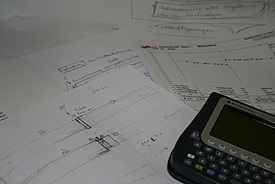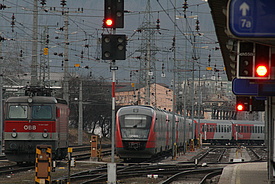Planning, Construction

Planning and construction of new railway lines, or the extension of existing ones, require a target timetable which itself is based on demand forecasts. Connections to the existing network and its timetable are essential constraints to consider. The target timetable specifies different train types and their stopping pattern. Due to the often very long duration of legal processes, demand forecasts need to consider demographic developments as well as other planned projects which may influence traffic movements in the region.
The planning process for new or existing railway lines includes alignment, selection of components, construction schedules and determination of construction sections. In order to achieve these plans, construction sequences allowing step to step implementation up to the selection of machinery need to be investigated.
Operation, Maintenance

The main research activities of the institute cover the interaction of quality of investment and maintenance requirements and therefore the optimization of life-cycle-costs of railway tracks. A precondition for the assessment of track in general and innovative components is the analysis of their behaviour. Furthermore, the times of reinvestment and maintenance measures need to be determined. Operational consequences of measures need to be considered to finally provide an optimised and reliable procedure for railway asset management.
Basic data are provided by the recording cars supplemented with asset information as traffic load, age of track and components or maintenance actions. A long-time cooperation with ÖBB (Austrian Federal Railways) enabled the compilation of a data base out of that, wherein all measured values are provided chronologically as time sequences. This forms a sound base for all evaluation as it allows studying track behaviour over time for specific boundary conditions. Identified trends enable predicting of behaviour. Furthermore, this is the premise for preventive maintenance and therefore the development of technically optimised maintenance options. Within these analyses, the behaviour of different vehicles can be analysed to finally determine track access charges on the cost by cause principle. A cooperation in this field with SBB (Swiss Federal Railways) led to the implementation of a new system of track access charges in Switzerland.
Assessment

Research of technical maintenance options is complemented by economic assessments based on life cycle costs. Therefore, finding the economically best alternative for investment and maintenance can be identified. This is true for standard components and maintenance tasks as it is for innovative solutions. At the same time, operational hindrances caused by track works need to be considered since they increase maintenance costs (Costs for Operational Hindrances). Technical forecasts and their economic assessments enable predictions for future track works including their respective budgets.
The key area for research concerning assessment is technical and economic controlling of investment and maintenance projects. The applied methodology, which for example is used by the Austrian Federal Railways (Österreichische Bundesbahnen, ÖBB), enables an economical ranking of all track projects. Expanding this approach from superstructure to entire track is part of the current research regarding technology and assessment. International cooperation with various infrastructure managers in Europe and collaboration with the Heavy Haul Association enforce the data base for further research.
Contact
Institute of Railway Engineering and Transport Economics
Rechbauerstraße 12/II
8010 Graz
Austria
Tel.: +43 (0) 316 / 873 - 6216
Fax: +43 (0) 316 / 873 - 106216 office.ebw@TUGraz.at
www.EBW.TUGraz.at
